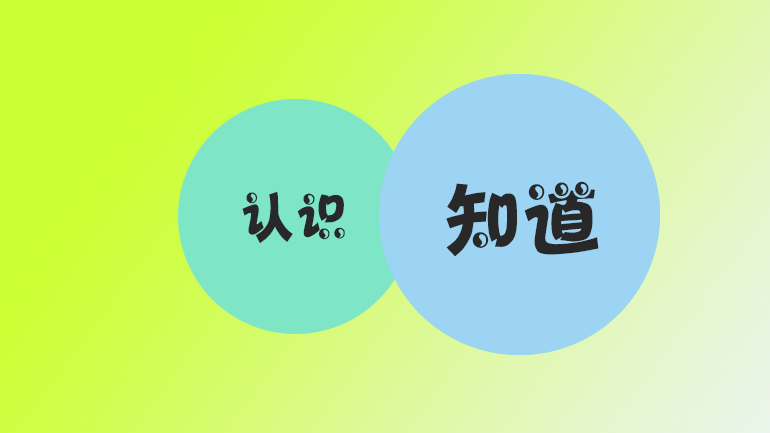
There are many characters or grammar patterns that can often confuse learners of Chinese. This article focuses on the two bigrams, 认识 (rèn shi) and 知道 (zhī dao).
汉语学习者在学习汉语的时候可能会遇到很多模棱两可的词语或语法结构。本文将着重介绍“认识(rèn shi)”和“知道(zhī dao)”这两个词。
First, let's take a look at the dictionary definitions of 认识 and 知道:
首先,请看“认识”和“知道”在词典中的释义:
认识 (rèn shi): to know / to recognize / to be familiar with / to get acquainted with sb / knowledge / understanding / awareness / cognition
知道 (zhī dao): know / be aware of
认识 is most commonly used to imply familiarity with another person, place or object through a previous experience.
“认识”是指通过以往的亲身经历,对某人、某个地方或某物感到熟悉。
知道 suggests knowledge of a person, place or object, but has never been introduced to the person or been to the place physically.
“知道”是指了解某人、某地或某物,但从来没有见过这个人或去过那个地方。
One way to remember how to use these bigrams is to look more closely at the characters. Let's begin with 认识.
要准确地使用这两个词,我们得先了解它们的构造。首先,我们看一下“认识”的构造。
认 (rèn) – to recognize / to know / to admit
To understand the original meaning of the character 认 we look at the traditional character: 認. The character's meaning was "to accept something reluctantly". The simplified character looks very different, but I remember this character by taking the radical 讠(yán), the speech radical and the 人 (rén), the person radical and imagining that on seeing the "man", I admit that I know him.
从“认”的繁体字“認”可知该字的本意为“愿意接受某事”。简体字“认”看起来和繁体字的差别很大,但是它是由表示说话的“讠(yán)”字旁和“人 (rén)”字旁构成,可以通过联想法记住该字:一看到那个“人”我就“承认”我对他有所了解。
识 (shí/shi) – to know / knowledge
識 is the traditional character of 识 and once referred to identifying the origin of weapons.
“识”的繁体字为“識”,本意为辨别武器的出处。
识 now combines the same 讠(yán) radical as in 认, together with 只 (made up of 口 and 八 radicals) meaning "only".
和“认”字一样,识字也包含“讠(yán)”字旁,其另外一部分为“只”(由“口”字和“八”字构成),“只”的意思为“仅仅”,相当于英文中的only。
知道 can also be explained by breaking down the characters.
接下来,我们通过同样的拆字法分析“知道”的意思。
知 (zhī) – to know
The radicals of the character are 矢 (shǐ) meaning arrow and 口 (kǒu) meaning mouth. In ancient China, this character was used to describe men gathering to have a "discussion about hunting".
“知”由“矢 (shǐ)”字和“口(kǒu)”字构成。“矢”指的是箭,“口”的意思是“嘴巴”。在古代中国,“知”的意思是指男人聚集在一起讨论狩猎事宜。
To remember this character, I take a more figurative approach than this traditional translation. If you are able to speak (口) quickly (矢) about it, you must "know" about the subject.
为了记住这个词,我用了更形象的方法。“口”隐含着“说”的意思,“矢”则是表明“很快”。如果你能很快地(矢)说出(口)某事,那么你必须要“知道”这件事。
道 dào – direction / way / road / path
道 shows a pictograph of a head which has often been used to mean chief. Originally, the meaning of this character meant "to guide". 首 (shǒu) combined with 辶(zǒu) meaning to walk, suggests that the "guide" will show you the right direction.
“道”中的象形文字“首”的意思通常为“头领”,其本意为“带领”。“辶zǒu”的意思为“走路”。“首(shǒu)”和“辶(zǒu)”结合构成“道”字,意指头领会为你指明正确的路。
Combining these two characters suggests that you 'know' the right path but have yet to travel it.
“知”和“道”组合在一起构成新词“知道”,表明你意识到正确的道路,但从来没走过这条路。
Now, let's look at 2 example sentences using 认识 and 知道:
请看关于“认识”和“知道”的两个例句:
(1) 我认识他。(wǒ rèn shi tā)= I know him.
(2) 我知道他。(wǒ zhī dao tā)= I heard about him. (or I know of him)
When the object is a person, the use of 认识 implies that people know each other, and have met each other before.
如果宾语为“人”的时候,“认识”意味着他们相互了解并且见过对方。
However, using 知道 in this case suggests that he is known by reputation, "he" could be famous, or you have heard of him before, and so you "know" that this person exists.
然而,“知道”则是指他是因为名气而被人所知,并非实际见过。“他”可能很出名或者你听说过他,因此你“意识到”这个人的存在。
Now, let's look at using 认识 and 知道 when the object is a place:
现在,我们看一下,当宾语为地点的时候,如何运用“认识”和“知道”:
(3) 我认识这个地方,我以前来过。(wǒ rèn shi zhè ge dì fang, wǒ yǐ qián lái guò.)= I know the place, I have been there before.
(4) 我知道这个地方,我朋友给我推荐过。(wǒ zhī dao zhè ge dì fang, wǒ péng you gěi wǒ tuī jiàn guò.) = I know of the place, my friend recommended it to me before.
Similarly to when the object is a person, 认识 means that "I" have been there before and have a previous memory of it.
和宾语为“人”一样,“认识”在这里意味着我曾经到过并记得那个地方。
知道 implies that "I" know of that place because I have heard about it, but have never visited and have no empirical proof that it exists.
知道则指“我”了解那个地方是因为我听说过它,但我从来没有亲自去过那个地方也没有实际证据证明这个地方的存在。
Finally, let's see how we use these bigrams when the object is a fact:
最后,让我们来看一下当宾语是指“某个事实”的时候,如何运用这两个词:
(5) 他终于认识到自己所面临的危险是什么。(tā zhōng yú rèn shi dào zì jǐ suǒ miàn lín de wēi xiǎn shì shén me.) = He eventually realized the dangers he faced.
When the object is fact, 到 (dào) is always used after 认识. This means that the person came to realize or became aware of something.
如果宾语是指某个事实,则通常在“认识”后面加“到(dào)”,表示某人了解或意识到某事。
知道 can also be used here, but the meaning is a little different.
在这里也可以用“知道”,但意思略有不同。
To summarize:
总结
认识 is used when a subject has knowledge of someone or something based on empirical evidence.
“认识”是指主体通过实践经验对某人或某物有所了解。
知道 is used when the subject knows "of" somebody or something, but has never met the person or seen the place physically.
“知道”是指主体听说过某人或某事,但从来没有见过这个人或去过这个地方。
Translated from: writtenchinese



 闽公网安备 35020302035673号
闽公网安备 35020302035673号
0 responses on "The differences between "认识" and "知道""